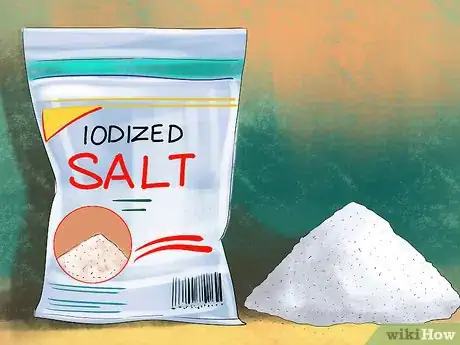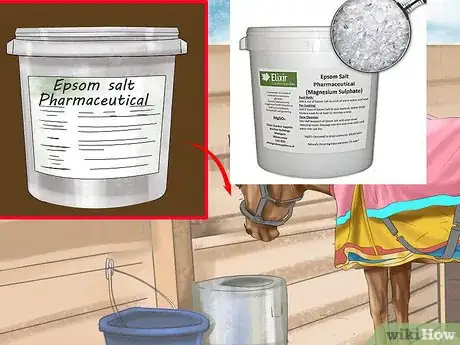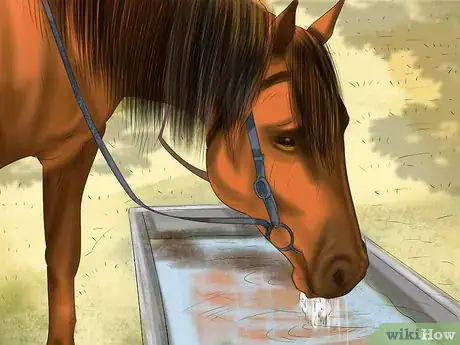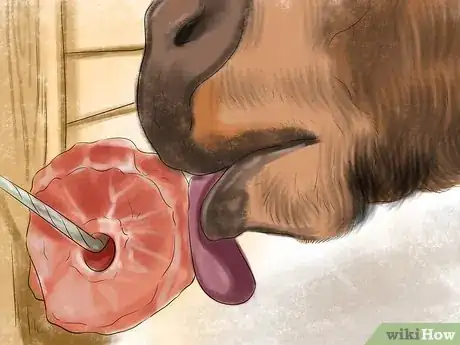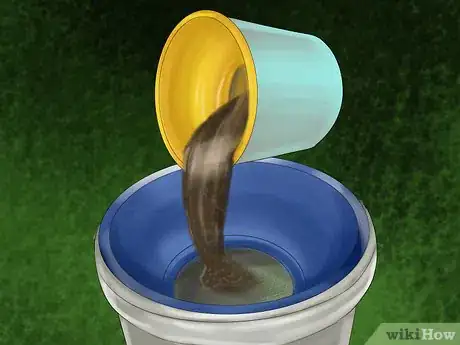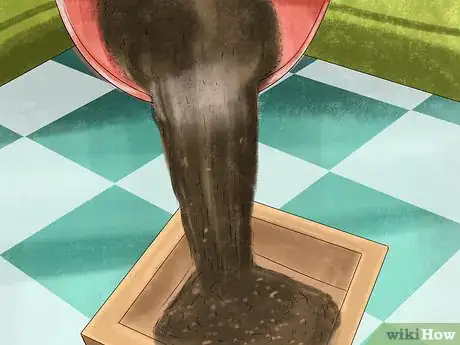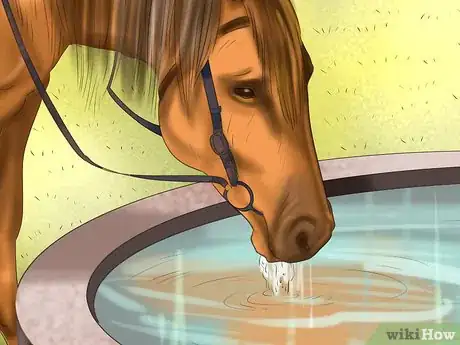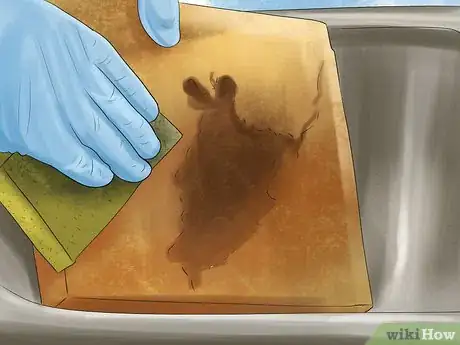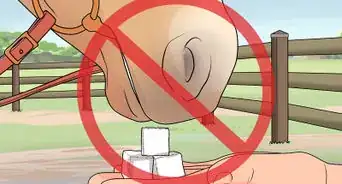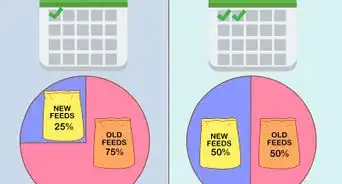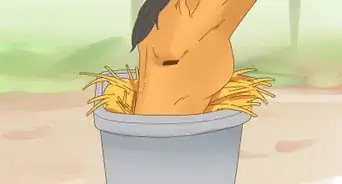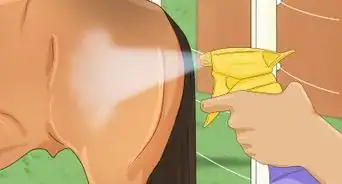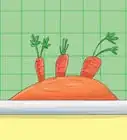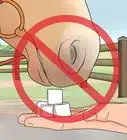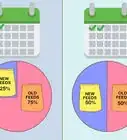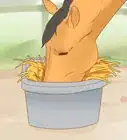This article was co-authored by Ryan Corrigan, LVT, VTS-EVN. Ryan Corrigan is a Licensed Veterinary Technician in California. She received her Bachelor of Science in Veterinary Technology from Purdue University in 2010. She is also a Member of the Academy of Equine Veterinary Nursing Technicians since 2011.
This article has been viewed 61,259 times.
In general, horses require about 1-2 ounces of salt a day to meet their nutritional requirements for sodium and chloride. If your horse lives in a hot climate or sweats often due to exercise, he may need 4-6 ounces of salt a day.[1] A horse that has inadequate salt levels can start to develop abnormal eating behaviors like licking or chewing objects that have salt or licking and eating dirt. The horse may also drink less water, leading to an increased risk of impaction colic and may stop eating, leading to poor muscle coordination and other health issues.[2] Ensure your horse is receiving enough sodium and chloride by making a loose salt mix or a salt block.
Steps
Making a Loose Salt Lick
-
1Use salt that is meant for animal consumption. Look for salt made for horses at your local pet store or feed store and buy it in bulk. Check that the salt is not a mineral salt blend, such as red salt, or salt that is meant for de-icing roads. If you are introducing your horse to a salt lick, start with plain white salt or iodized table salt.[3]
- The type of salt that is best for your horse will depend on his nutritional needs and his current diet. If your horse only needs sodium and chloride, table salt is a great option. Some horses may do better with iodized salt or trace mineral salt if they are not getting enough supplements in their diet.
- If you are giving your horse commercial feed or a vitamin/mineral supplement, he does not need iodized salt as he is already getting enough iodine in his diet. A build up of iodine in your horse can lead to other health issues.[4]
- Always talk to your vet before you give your horse any homemade products, including a salt lick.
-
2Add the salt to your horse’s feed. Start by giving your horse two tablespoons of salt a day for a few days in his feeder. Gradually build up to a full dose of four tablespoons of salt a day so your horse can get used to the taste of the salt.[5]
- If your horse lives in a very hot climate or sweats profusely every day, you may want to start with two tablespoons a day and up the dose to five to six tablespoons a day over a period of one to two weeks.[6]
- Most horses will regulate their own salt consumption and only consume as much salt as they need. If your horse appears to be salt starved, start with a controlled amount in his feed to help his body adjust to the salt intake slowly.
Advertisement -
3Try putting granulated salt in a bucket attached to your horse’s stall. If you would rather allow your horse to consume salt of his own accord when he feels salt deprived, you can fill a bucket halfway with granulated salt and hang the bucket in an area that is easy to access in your horse’s stall. Look for a location that will protect the bucket from the weather.[7]
- This is a good option for horses who are just starting to get used to salt in their diets, as free-choice salt consumption may be more inviting than licking a salt block that will be rough on your horse’s tongue.
-
4Make sure your horse gets lots of fresh water. Giving your horse lots of fresh, clean water will help the salt to circulate properly in his body. As well, the water will help your horse flushes out any excess sodium and chloride from his system.
- If your horse is getting too much salt, and not enough water, he may drink an excessive amount of water and urinate more often than usual. As long as you provide enough fresh water in his stall, in addition to salt lick, he should be able to balance his salt intake with his water intake.
Making a Salt Lick Block
-
1Be aware of the possible issues with a salt blocks. Salt blocks were originally designed for cattle, who have rough tongues that make it easy to get salt by licking a hardened salt block. Horses have softer tongues and may have a hard time getting the salt they need from a salt block, especially if they are older or have bad teeth. Keep this in mind when you are deciding between a loose salt mix that you scatter in your horse’s feed or his stall and a salt block you hang in his stall.[8]
- Some horses can also overindulge in salt if they have access to a salt block. As a horse owner, you have less control over how much salt your horse consumes when you give him a salt block. However, a salt block requires less maintenance and often horses will regulate their own salt intake when they have access to a salt block.[9]
-
2Make the salt block. Use mineralized salt if your horse’s feed does not contain any minerals or if you are not giving him a vitamin/mineral supplement. If you do use feed or a concentrate with minerals or a vitamin/mineral supplement, you can use plain, white salt.[10] To make your own salt block, you will need:
- 14 lbs of table salt, iodized salt, or mineralized salt.
- 3.3 lbs bone meal.
- 1.3 lbs lime.
- 3.5 lbs clay.
- Water.
- A large bowl or tub.
- A large wooden spoon or stick.
- Old pots and pans.
- Avoid adding a sweetener, like molasses, to your salt blocks. Horses can consume too much of the molasses salt block at once due to the sweet taste and this can lead to health issues.
-
3Pour the 14 lbs of salt, 3.3 lbs bone meal, 1.3 lbs lime, and 3.5 lbs clay in a large bowl or tub. Add enough water so the texture becomes soft and easier to mix together. Use the large wooden spoon or stick to mix the ingredients until they are well blended.
- You should continue to add water so it is easy to stir and blend the ingredients but do not add too much water as you do not want the mixture to become watery. The mixture will have the right consistency when you can easily stir and blend the mixture with the wooden spoon or stick.
-
4Remove the excess water from the mixture. Once you feel the mixture has been thoroughly mixed, drain as much water as possible from the mixture by molding the mix, squeezing water out, and draining it. Do this until you cannot get any more water out of the mixture.
-
5Use your hands to mold the mixture into blocks. Most salt blocks for horses come in five pound blocks, so try to mold the mixture into blocks that are around four to five pounds. Make your blocks about the size of a standard paving brick. That way, it will fit in standard salt lick wall mounts or dishes.
- Place the blocks in old pots or pans so they can harden. Leave the blocks in a cool, shaded area to allow them to dry and harden. This will take about two weeks.
-
6Hang the salt block in an easy to access spot in your horse’s stall. You can hang the salt block using rope or simply put it on the ground in a spot that is easy to access in your horse’s stall. Check to make sure your horse is ingesting enough of the salt block, especially if you have multiple horses in one area. One horse should consume a five-pound salt block within two months if he is getting enough salt in his diet.[11]
- If you keep your horse in a stall, you can find a wall mount that goes on the wall of the stall. The salt block will fit into the mount so that it stays clean but is easy for your horse to eat. If your horse is kept in a field, you can get a dish for the salt lick.
- Keep in mind hanging the salt block will ensure it stays cleaner for longer, and more appetizing, than if it is lying on the ground in the dirt and the hay.
-
7Provide lots of fresh water to help your horse stay hydrated. It’s important that you give your horse lots of fresh, clean water so his body can process the salt in his diet. Having access to fresh, clean water, as well as a daily salt intake, will ensure your horse flushes out any excess sodium and chloride from his system.
-
8Keep the salt block clean. Over time, your horse’s salt block may get dirty due to exposure to the elements and exposure to dirt and hay in his stall. Keeping the salt block clean will make it more enticing to your horse and encourage him to use the block. Clean the block as needed by hosing it down with water in a metal or plastic tub.
Expert Q&A
-
QuestionI made this following the instructions and put the mix in a sack hanging in a shed. It has been there for two months and it's still not hardened. Can I remix it and add anything to fix it?
 Ryan Corrigan, LVT, VTS-EVNRyan Corrigan is a Licensed Veterinary Technician in California. She received her Bachelor of Science in Veterinary Technology from Purdue University in 2010. She is also a Member of the Academy of Equine Veterinary Nursing Technicians since 2011.
Ryan Corrigan, LVT, VTS-EVNRyan Corrigan is a Licensed Veterinary Technician in California. She received her Bachelor of Science in Veterinary Technology from Purdue University in 2010. She is also a Member of the Academy of Equine Veterinary Nursing Technicians since 2011.
Licensed Veterinary Technician Don't try to remix it. Instead, toss it and try again. It's possible that putting it into a sack prevented it from drying properly. For your next attempt, look for a better mold that lets your salt block breathe more so it dries out faster.
Don't try to remix it. Instead, toss it and try again. It's possible that putting it into a sack prevented it from drying properly. For your next attempt, look for a better mold that lets your salt block breathe more so it dries out faster. -
QuestionYour ingredients include "lime," which is a calcium-rich mineral. The illustration shows "limes," the green citrus fruit. Which one is intended?
 Ryan Corrigan, LVT, VTS-EVNRyan Corrigan is a Licensed Veterinary Technician in California. She received her Bachelor of Science in Veterinary Technology from Purdue University in 2010. She is also a Member of the Academy of Equine Veterinary Nursing Technicians since 2011.
Ryan Corrigan, LVT, VTS-EVNRyan Corrigan is a Licensed Veterinary Technician in California. She received her Bachelor of Science in Veterinary Technology from Purdue University in 2010. She is also a Member of the Academy of Equine Veterinary Nursing Technicians since 2011.
Licensed Veterinary Technician You should always check with your vet before giving your horse any food or minerals. However, lime the mineral is likely the correct ingredient.
You should always check with your vet before giving your horse any food or minerals. However, lime the mineral is likely the correct ingredient.
Things You'll Need
Making a Loose Salt Lick
- Table salt or iodized salt, in bulk
- A measuring spoon
- A bucket
- Access to fresh, clean water
Making a Salt Lick Block
- 14 lbs of table salt, iodized salt, or mineralized salt
- 3.3 lbs bone meal
- 1.3 lbs lime
- 3.5 lbs clay
- Water
- A large bowl or tub
- A large wooden spoon or stick
- Old pots and pans
References
- ↑ https://www.spalding-labs.com/community/b/morgan_murphy/archive/2015/04/15/the-pros-and-cons-of-giving-horses-salt-licks.aspx
- ↑ https://www.spalding-labs.com/community/b/morgan_murphy/archive/2015/04/15/the-pros-and-cons-of-giving-horses-salt-licks.aspx
- ↑ https://www.spalding-labs.com/community/b/morgan_murphy/archive/2015/04/15/the-pros-and-cons-of-giving-horses-salt-licks.aspx
- ↑ http://www.equisearch.com/discoverhorses/article/the-importance-of-salt
- ↑ http://www.equisearch.com/discoverhorses/article/the-importance-of-salt
- ↑ http://www.horsefeedblog.com/2010/11/feeding-salt-to-horses/
- ↑ http://www.equisearch.com/discoverhorses/article/the-importance-of-salt
- ↑ https://www.spalding-labs.com/community/b/morgan_murphy/archive/2015/04/15/the-pros-and-cons-of-giving-horses-salt-licks.aspx
- ↑ https://www.spalding-labs.com/community/b/morgan_murphy/archive/2015/04/15/the-pros-and-cons-of-giving-horses-salt-licks.aspx
About This Article
To make a salt lick block for your horse, start by combining salt, bone meal, lime, and clay in a large tub with enough water to mix everything together. When the mixture is well-blended without being watery, mold it with your hands, squeeze it out, and drain it to remove as much water as possible. Next, mold the mixture into blocks, then store them in a cool, shaded area to dry for about 2 weeks. Finally, use rope to hang the blocks up in your horse’s stall. For more tips from our Veterinary co-author, including how to make a loose salt lick for your horse, keep reading!
